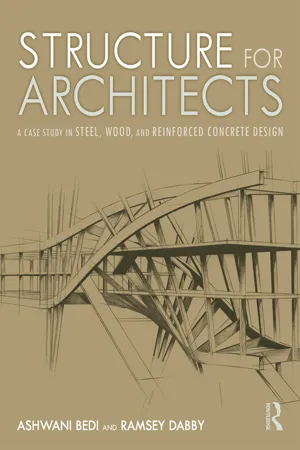
Structure for Architects
A Case Study in Steel, Wood, and Reinforced Concrete Design
Ashwani Bedi, Ramsey Dabby
- 226 pages
- English
- ePUB (adapté aux mobiles)
- Disponible sur iOS et Android
Structure for Architects
A Case Study in Steel, Wood, and Reinforced Concrete Design
Ashwani Bedi, Ramsey Dabby
À propos de ce livre
Structure for Architects: A Case Study in Steel, Wood, and Reinforced Concrete Design is a sequel to the authors' first text, Structure for Architects: A Primer, emphasizing the conceptual understanding of structural design in simple language and terms. This book focuses on structural principles applied to the design of typical structural members—a beam, a girder, and a column—in a diagrammatic frame building. Through the application of a single Case Study across three key materials, the book illustrates the theory, principles, and process of structural design. The Case Study progresses step-by-step for each material, from determining tributary areas and loads through a member's selection and design.
The book addresses the frequent disparity between the way architects and engineers perceive and process information, with engineers focusing on technical aspects and architects focusing on visual concepts. Structure for Architects: A Case Study in Steel, Wood, and Reinforced Concrete Design presents readers with an understanding of fundamental engineering principles through a uniquely thematic Case Study. Focusing on the conceptual understanding of structural design, this book will be of interest to architecture students and professionals looking to understand the application of structural principles in relation to steel, wood, and concrete design.
Foire aux questions
Informations
1 Introduction to Structural Design


1.1 Removing a Bearing Wall

Option 1
Option 2
Option 3

2 Structural Design Methodologies
2.1 Building Codes and Industry Organizations

